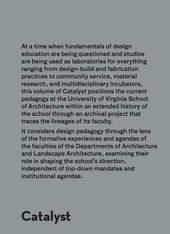
|
Catalyst: Lineages and Trajectories
Paperback / softback
Main Details
Description
At a time when fundamentals of design education are being questioned and studios are being used as laboratories for everything ranging from design-build and fabrication practices to community service, material research, and multidisciplinary incubators, this volume of Catalyst positions the current pedagogy at the University of Virginia School of Architecture within an extended history of the school through an archival project that traces the lineages of its faculty. It considers design pedagogy through the lens of the formative experiences and agendas of the faculties of the Departments of Architecture and Landscape Architecture, examining their role in shaping the school s direction, independent of top-down mandates and institutional agendas. With contributions of Ghazal Abbasy-Asbagh, Marcela Gracia Acosta, Karilyn Johanesen, Margaret Rew, Sam Eldredge, Del Hepler, Bess Lovern, Kaitlynn Long, Seth Salcedo, Emily Richards and University of Virginia School of Architecture Faculty, Students, and Alumni"
Author Biography
Ghazal Abbasy-Asbagh is a lecturer at the University of Virginia School of Architecture. She is the editor Catalyst: Conditions and Responses (ACTAR, 2013).
Reviews"This book in two parts documents the faculty and student output of the architecture and landscape architecture departments at the University of Virginia School of Architecture. There is a concerted attempt to make it something special: each of the two books is small; they fit together into a slipcase; and they are accompanied by a foldout with two "maps." The Lineages book serves as an archival project "that traces the lineage of the school's faculty," so logically it is structured as a collection of interviews. The Typologies book, on the other hand, presents studio projects from the 2013-2014 school year." --John Hill, A Daily Dose of Architecture
|